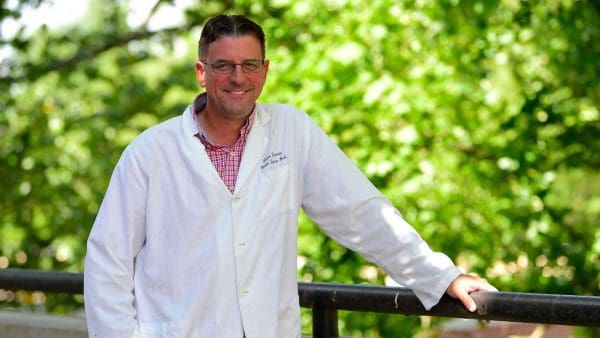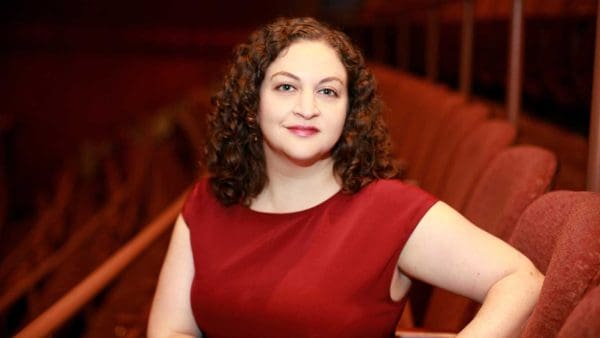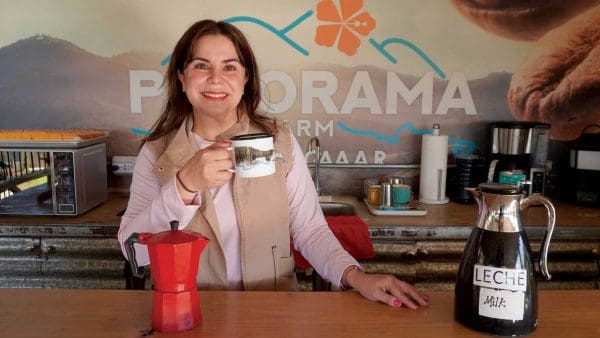
Frame by frame, a woman sands down her windowsills, turning layers of lead paint into so much dust. She worries about the effects the dust might have on her cats, whooshing them away. Yet, when the woman takes her own mask off, she has a sneezing fit. The warnings about lead paint under each drawn panel add to the tension: Is she doing enough to care for herself? Should she even be doing this job?
But the subject of the cartoon isn’t home improvement safety. The elaborate narrative and austerely drawn images explore the pain of miscarriages, as well as the tangle of emotions and worries women might have about pregnancy, motherhood, and their bodies.
The story is one chapter in Nonpartum, a graphic novel-in-progress by Rachel Masilamani ’99, an artist who has fashioned a love of drawing and narrative into a running commentary on modern life. Her cartoons, which have appeared in the Los Angeles Review of Books, Mutha Magazine, and a collection for the writers’ group PEN, are a universe away from the escapism of comic book superheroes or the hysteria of dystopian sci-fi stories. Her comics deal in real life, magnified.

Masilamani craftily braids the personal with the political, writing and drawing about bringing new life into the world, dealing with the health care system, or living amid the brooding and scary national mood.
“My goal is not to entertain,” says Masilamani, 42. “I want to start a conversation, to develop points for thought so people can recognize parts of themselves. It’s a fundamental joy to recognize yourself in a piece of art.”
She began developing her skills while studying anthropology and art history at the Krieger School. A class in comic art with Hopkins instructor Tom Chalkley, an inveterate cartoonist, reawakened a childhood love of storytelling and making pictures. Some courses at the nearby Maryland Institute College of Art helped shape her vision as well.
“I learned that visual art is more than a mechanical or aesthetic thing,” she says. “It’s an intellectual exercise too.”
At Hopkins, her rangy intellect was already in full bloom. As an anthropology major, she investigated several types of signifiers, including why the uniform of the British skinhead (leather bomber jacket, black boots) was perceived as a threat, especially given that other, less menacing groups wore similar clothes. As an art history minor, she explored the unique portrait perspective that the German couple Bernd and Hilla Becher employed in their photographs of industrial buildings.
“Hopkins was a really great environment for an independent thinker,” she says. “School really didn’t do too much for me until I got there. I had the luxury, once I figured out what I was into, of really going after it.”
A four-year work-study job in the university’s book preservation office gave her an interest in how books are constructed and how people will use them. “Now, as I put my own books together, I think about how people will hold them, how they’ll be looked at,” she says.
Masilamani’s combination of drawing and storytelling has developed into something all its own, says one of her mentors. Her late adoption of the form helped her become an original. “Rachel’s so unusual in that she didn’t grow up reading comics—she didn’t really pay attention to them till she was 18,” says Chalkley.
The unique ways Masilamani employs variances in the white space between frames can serve as punctuation or additional comment, he adds. What’s more, she supplements dialogue balloons with captions, allowing her to add meta commentary or new trains of thought to her work.
The lead paint story in Nonpartum includes a side story involving a boy’s attempt to swim the length of a river. His mother follows along in a canoe, monitoring his progress and how he’s feeling. He sinks at the end, the mother helpless to do anything about it—a metaphor for Masilamani’s own gestation experience.
“I’m trying to put things out there that we usually don’t talk about,” Masilamani says. “I’ve had miscarriages, which are incredibly common, but it’s rare to have a conversation with someone about them. I’m hoping stories like this open up that window so we can have those conversations.”




